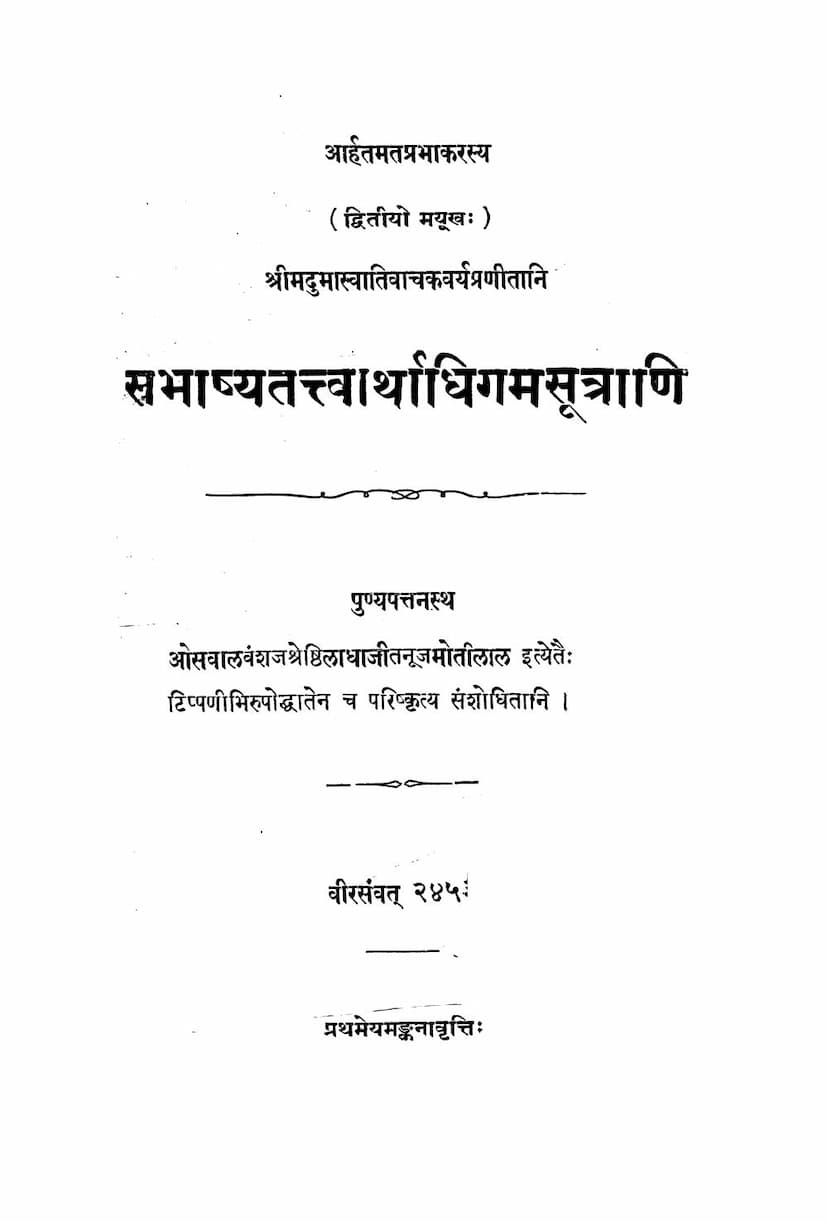Sabhashya Tattvarthadhigam Sutrani
Added to library: September 2, 2025

Summary
This is a comprehensive summary of the Jain text "Sabhashya Tattvarthadhigam Sutrani" by Acharya Umāsvāti, as presented in the provided scanned pages. The summary is based on the introductory sections, the table of contents, and snippets from the body of the text.
Book Title: Sabhashya Tattvarthadhigam Sutrani (Tattvārthādhigama Sūtrāṇi with commentary)
Author: Acharya Umāsvāti Vāchakavarya
Editor/Commentator/Publisher: Motilal Laghaji Oswal
Overall Structure and Purpose: The text is the highly revered Tattvarthadhigama Sutra, a foundational scripture in Jainism, presented with a detailed commentary (Bhashya) and further annotations and introduction by the editor. The Tattvarthadhigama Sutra, composed of ten chapters, aims to systematically explain the core principles of Jainism, making it accessible to both beginners and advanced scholars. It is considered authoritative by both the Shvetambara and Digambara traditions, although there are slight variations in the number of sutras between them.
Key Themes and Content:
The Tattvarthadhigama Sutra, and by extension this commentary, covers the fundamental Jain philosophy, providing a comprehensive understanding of:
-
The Path to Liberation (Moksha Marga): The ultimate goal of Jainism is liberation from the cycle of birth and death. This path is defined by the attainment of Right Faith (Samyak Darshan), Right Knowledge (Samyak Gyan), and Right Conduct (Samyak Charitra). These three are interdependent and essential for achieving liberation.
-
The Seven Tattvas (Realities): The text elaborates on the seven fundamental principles or realities of the universe according to Jainism:
- Jiva (Soul): The sentient soul, which is inherently pure and possesses consciousness, knowledge, perception, bliss, and energy.
- Ajiva (Non-soul): Everything that is not a soul, including matter, space, time, and principles of motion and rest.
- Asrava (Influx): The influx of karmic particles into the soul due to passions and activities.
- Bandha (Bondage): The actual bondage of karmic particles to the soul, which obscures its true nature.
- Samvara (Stoppage): The prevention of the influx of new karmic particles through restraint and ethical conduct.
- Nirjara (Shedding): The shedding of accumulated karma through austerities and penance.
- Moksha (Liberation): The state of complete freedom from karma, resulting in the soul's inherent qualities being fully realized.
-
Knowledge (Gyan): The text categorizes knowledge into different types:
- Paryaksh (Indirect Knowledge): Moti Gyan (Perception) and Shrut Gyan (Scriptural Knowledge).
- Pratyaksh (Direct Knowledge): Avadhi Gyan (Clairvoyance), Manahparyaya Gyan (Telepathy), and Keval Gyan (Omniscience).
- It also discusses the variations in knowledge based on the soul's state and the classification of the types of knowledge and their limitations.
-
The Soul (Jiva): The text describes the soul's nature, its different states (worldly beings and liberated souls), the characteristics of souls in various life forms (based on the number of senses, the presence of mind, etc.), and the states of existence (hellish beings, animals, humans, and celestial beings).
-
The Non-soul (Ajiva): It details the nature of Ajiva substances, including Dharma (principle of motion), Adharma (principle of rest), Akasha (space), Pudgala (matter), and Kala (time). Pudgala is further described in terms of its properties like touch, taste, smell, color, sound, subtlety, grossness, and its atomic and compounded forms.
-
Cosmology: The text presents a detailed cosmology, describing the different realms of existence, including the seven hells (Adho Loka), the realms of celestial beings (Devaloka and Vaimanika), and the different continents and oceans. It also outlines the structure of the universe, the lifespan of beings in different realms, and the nature of the celestial bodies (Sun, Moon, stars).
-
Karma: A significant portion of the text is dedicated to the theory of Karma, explaining its influx (Asrava), bondage (Bandha), types of karma (Prakriti, Sthiti, Anubhava, Pradesha), the duration of karmic bondage, and the consequences of different karmic actions.
-
Conduct and Practice: The text details ethical conduct, including vows (Vratas), subsidiary vows (Anuvratas and Mahavratas), the eleven vows for monks, and the twelve types of austerities (Tapas), both external and internal. It also discusses the importance of contemplation (Anupreksha) and the practice of meditation (Dhyana).
-
Commentaries and Traditions: The introduction highlights the significance of the Tattvarthadhigama Sutra across Jain traditions and lists various prominent commentaries from both Shvetambara and Digambara scholars, showcasing the text's universal acceptance and enduring relevance.
Editor's Contribution (Motilal Laghaji Oswal): The editor has meticulously compiled and presented this edition. His contributions include:
- A detailed introduction (Prastavika) explaining the book's purpose and the significance of the Tattvarthadhigama Sutra.
- Annotations (Tippani) that clarify difficult concepts, technical terms, and cross-references within the text.
- Compilation of various relevant texts and treatises, including commentaries from respected scholars.
- Inclusion of appendices that provide helpful resources for readers, such as a chapter-wise index of sutras, a list of sutras with Shvetambara-Digambara variations, a list of utilized texts, and a glossary of technical terms.
- Acknowledgement of the assistance received from various individuals and institutions in bringing this publication to fruition.
Overall Significance: The "Sabhashya Tattvarthadhigam Sutrani" serves as an indispensable resource for anyone seeking to understand the profound philosophical and ethical framework of Jainism. It systematically guides the reader through the path of spiritual purification and liberation, emphasizing the interconnectedness of all actions, their karmic consequences, and the ultimate potential of the soul. The meticulous commentary and editorial additions make this edition particularly valuable for serious study.